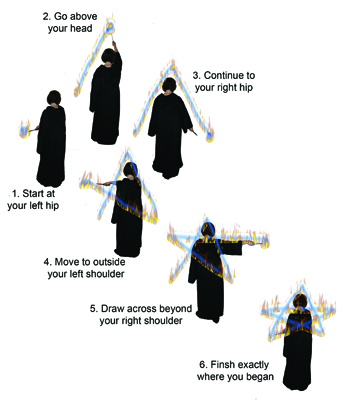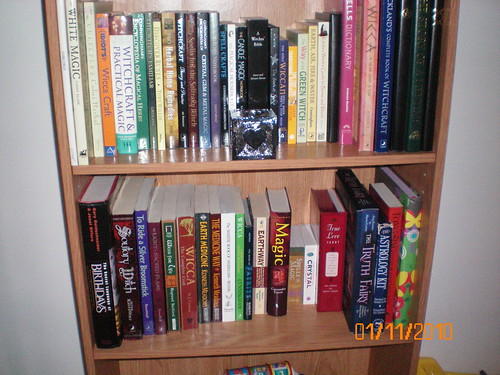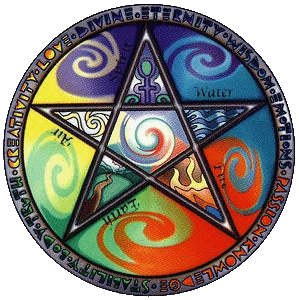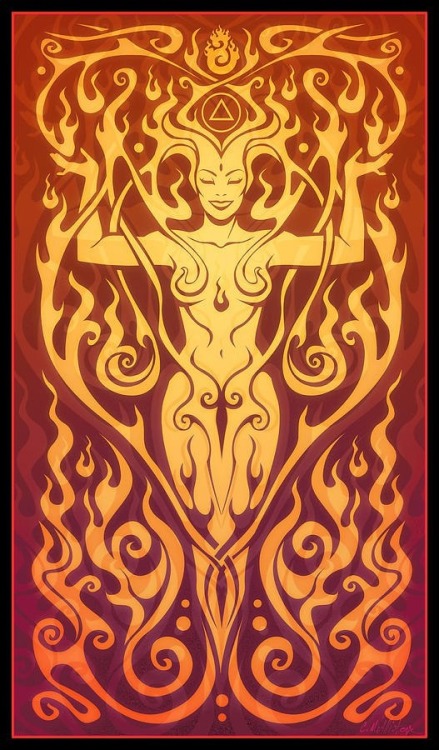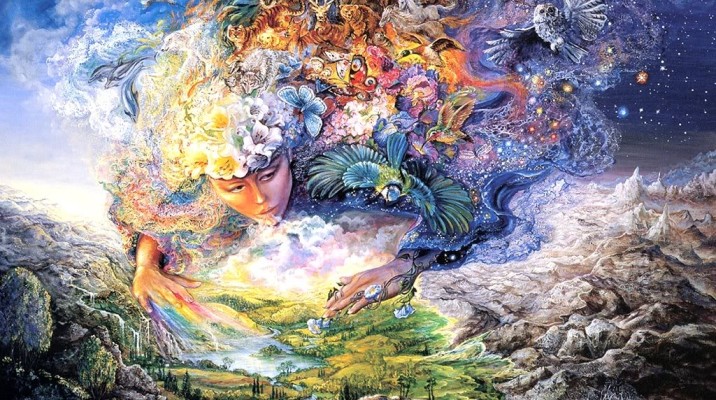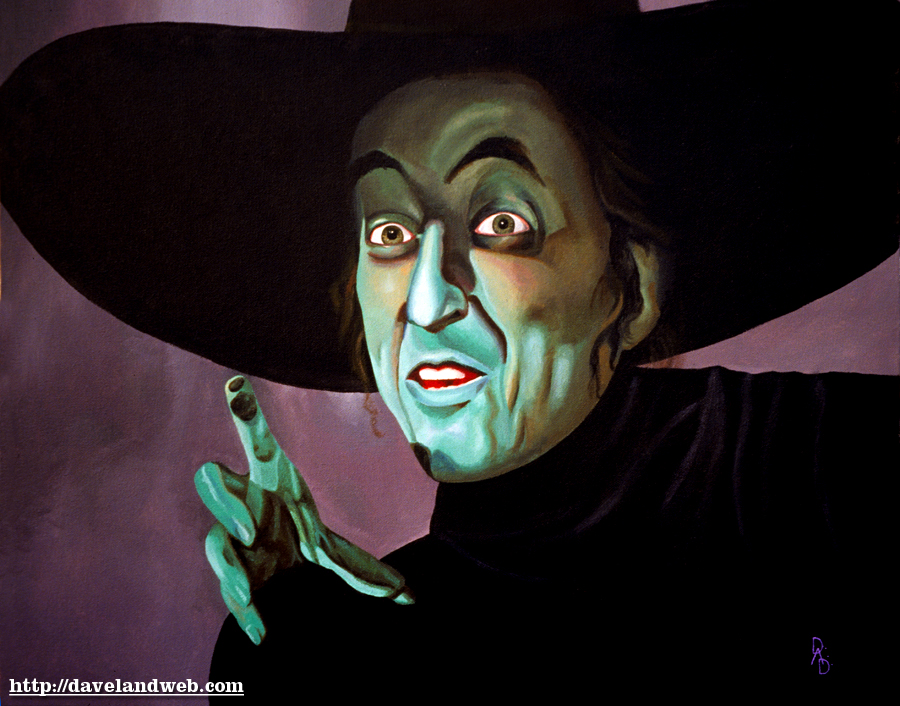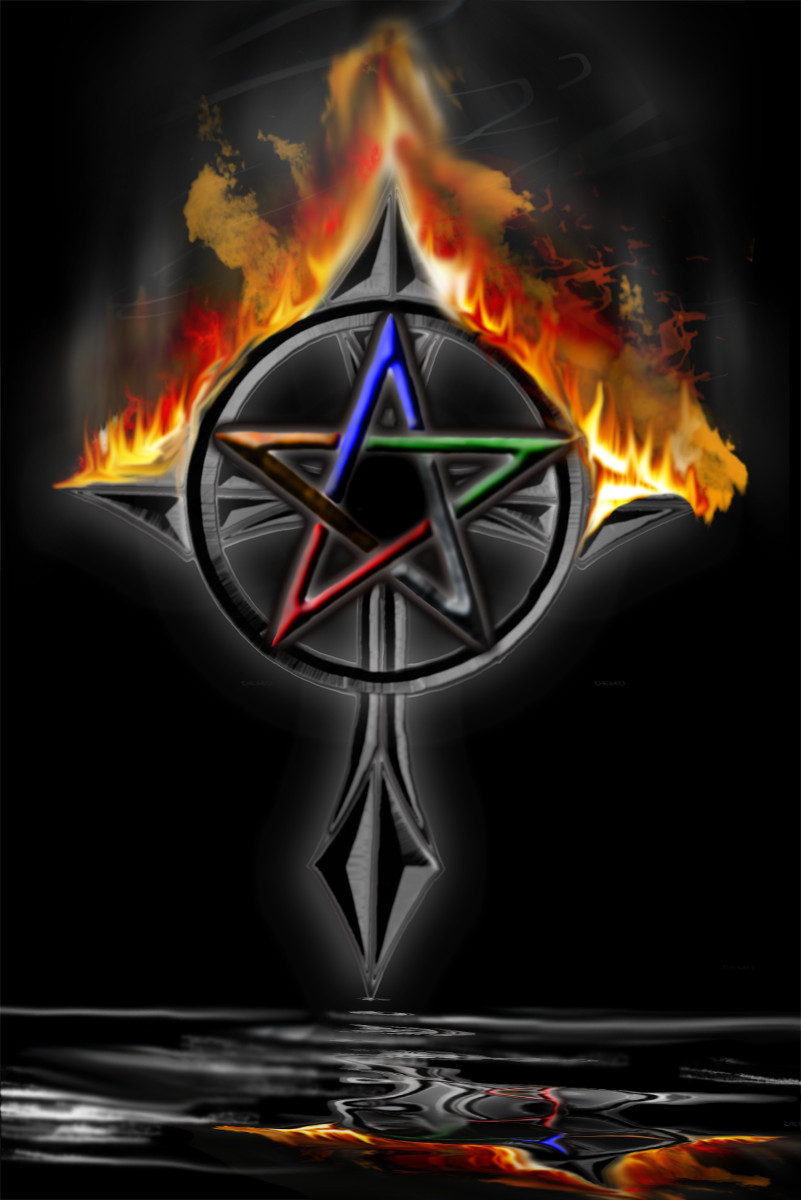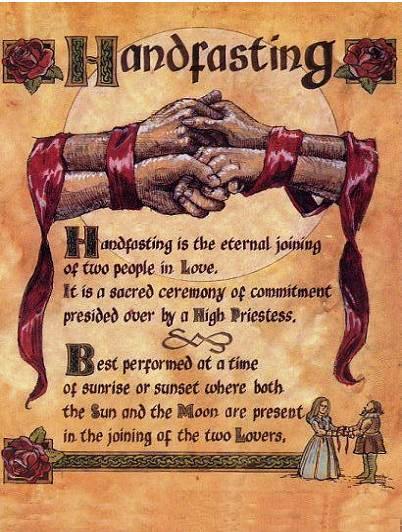Hi everyone! In my last post we discussed the Pagan holiday Lammas. During Lammas is usually a good time of the year to handfast or "marry" the love that you decide to love. In this post, thanks to this very general and interesting site handfasting.org that I will give you all the information needed to know about handfasting and three different rituals that are commonly used for handfasting.
What is Handfasting?
Handfasting refers to one of two types of ceremonies, either a "wedding" or a betrothal of a year and a day, which the participants can then decide to renew or not at the end of that period. Handfasting is quite popular today, among many people who find that their own lifestyles call for an alternative joining ceremony to that provided by more typical weddings. Handfasting can be used by couples of the same sex, or by group marriages who wish to have more than two people in their families.
They can be used by people who are members of Pagan religions, or by people who don't necessarily share the same beliefs. There are also Christian and other folks who choose to use handfasting as their wedding rituals for various reasons, so don't feel excluded from these resources.
The History of Handfasting
Handfasting at one time was the only way that couples could be engaged and/or get married because the church let the civil government of the period take care of these matters. In the British Isles, Handfasting was the old pagan ritual of marriage and it remained legal in Scotland all the way up to 1939, even after Lord Harwicke’s Act of 1753 declaring that marriages in England were legal only if performed by a clergyman. After Lord Harwicke’s Act, the Scottish border town, Gretna Green became a mecca for eloping couples from England who fled there to perform their own Handfastings. In those times, the couple themselves performed the Handfasting before witnesses. It was also used in Scotland for the engagement period of a year and a day before a wedding was proved.
The very word handfasting got it's origin in the wedding custom of tying the bride and groom's hands (actually, wrists) together. In some versions, this is only done for as long as the ceremony lasts, but in others, the cord is not untied until the marriage is physically consummated.
Handfasting is the marriage rite used toady by many Heathens, neo-Pagans and Wiccans. The term itself comes from the custom of shaking hands over a contract. It is a custom steeped in old tradition.
In most Pagan traditions today it may mean a non-state registered wedding or one in which a marriage license is filed. For some it is a year and a day, renewable "so long as love shall last" and for others a commitment to be together through many lives.
There are probably as many rituals for this as there are people who have joined themselves together.
The hands are generally bound with a cord as part of the ritual.
One custom is that while facing each other, the couple placed their right hands together and then their left hands together to form an infinity symbol while a cord is tied around their hands in a knot. Another custom is that the man and woman place their right hands only together while a cord is used to tie a knot around their wrists.
The ritual itself might have been led by a respected non-church affiliate such as a Chieftain, Leader, Priest, Priestess, Shaman, or Elder of the community while the couple took turns reciting their vows of promise to be engaged for a year and a day in front of witnesses. On the last day of “the year and a day promise” they would then make a promise for infinity repeating their promise to each again. A cord is tied in a knot around their hand while the ritual takes place. This is where the term “tie the knot" came from when referring to getting engaged or married today.
In day of old, records were not kept who got engaged, married, had kids, and died. Today the Sacraments of the church has the responsibility of taking care of these things. Before the church took over these duties, these things were overseen by the whole community and therefore were set in law by their witnessing what happened between the couple making the promise.
If a handfasting was performed with the two left hands together without the tying of the knot, as was the custom of rich and influential German nobility, it meant that the woman was a mistress and would not be able to claim the name, inheritance, property, etc. of the real wife and was only in the protection of the man. But her offspring would be taken care of as legal heirs second in line to the man's legal and first wife. Having lots of children was once the only form of "Social Security" in one's old age. The previous combinations were all considered legal and binding in an engagement or marriage except for the “left hand ritual.”
The Handfasting gesture seems to have been derived from one of the ancient Indo-European images of male-female conjunction, the infinity sign, whose twin circles represented the sun (female) and the moon (male) or in some of the southern Mediterranean traditions it was sun (male) and moon (female).
Two-handed Handfasting still constituted a fully legal marriage throughout Europe whether the blessing of the church was sought or not. Clergymen, of course, recommended that newlyweds attend church as soon as possible after the signing of the contract and the Handfasting. Marriage is now one the Seven Sacraments that had been ignored by the church for centuries. Only the very wealthy and affluent could afford church marriages. Handfastings were under the jurisdiction of common law rather than canon law. In the 16th century in Switzerland, if couples were seen in public drinking together they could be considered married.

Subtle Wedding/Handfasting Ceremony
The following wedding ceremony was written to provide for Pagans who must of necessity be wed in the presence of the uninitiated who are not pagan and are perhaps unaware that the bride and groom are pagan. Replace the words Bride and Groom below with the names of the happy couple. This ceremony was used by both my wife and myself and by my sister and her husband. They modified the text at the point below where it says "loving each other wholly and completely" to add the phrase "forsaking all others" as they are into monogamy. Either version works beautifully, I recommend the participants rewrite where necessary to form a legal contract that they can and will keep. It is easy to avoid being an oathbreaker if you only swear to that that you will keep and avoid swearing to something just because the other party wants it or because it might be "expected" by the family. Notice: parts of this ritual were cribbed from the writings of others. I apologise in advance for failure to reference sources but after the fifteenth rewrite we had forgotten where we got the text and what was and what was not original to us. I doubt if there are quotes from other sources longer than paragraph length and thus should not be a copyright problem. If you see something that is yours, please send me mail and I will reference you in the future. Our thanks to those who paved the way. --Ryan Hunter
[PRIEST] We have come together here in celebration of the joining together of Bride and Groom. There are many things to say about marriage. Much wisdom concerning the joining together of two souls,has come our way through all paths of belief, and from many cultures. With each union, more knowledge is gained and more wisdom gathered. Though we are unable to give all this knowledge to these two, who stand before us, we can hope to leave with them the knowledge of love and its strengths and the anticipation of the wisdom that comes with time. The law of life is love unto all beings. Without love, life is nothing, without love, death has no redemption. Love is anterior to Life, posterior to Death, initial of Creation and the exponent of Earth. If we learn no more in life, let it be this.
Marriage is a bond to be entered into only after considerable thought and reflection. As with any aspect of life, it has its cycles, its ups and its downs, its trials and its triumphs. With full understanding of this, Groom and Bride have come here today to be joined as one in marriage.
Others would ask, at this time, who gives the bride in marriage, but, as a woman is not property to be bought and sold, given and taken, I ask simply if she comes of her own will and if she has her family's blessing.
Bride, is it true that you come of your own free will and accord?
[BRIDE] Yes, it is true.
[PRIEST] With whom do you come and whose blessings accompany you.
[FATHER] She comes with me, her father, and is accompanied by all of her family's blessings.
[PRIEST] Please join hands with your betrothed and listen to that which I am about to say.
Above you are the stars, below you are the stones, as time doth pass, remember...
Like a stone should your love be firm like a star should your love be constant. Let the powers of the mind and of the intellect guide you in your marriage, let the strength of your wills bind you together, let the power of love and desire make you happy, and the strength of your dedication make you inseparable. Be close, but not too close. Possess one another, yet be understanding. Have patience with one another, for storms will come, but they will pass quickly.
Be free in giving affection and warmth. Have no fear and let not the ways of the unenlightened give you unease, for God is with you always.
Groom, I have not the right to bind thee to Bride, only you have this right. If it be your wish, say so at this time and place your ring in her hand.
[GROOM] It is my wish.
[PRIEST] Bride, if it be your wish for Groom to be bound to you, place the ring on his finger. (places ring on Groom's left ring finger)
Bride I have not the right to bind thee to Groom only you have this right. If it be your wish,say so at this time and place your ring in his hand.
[BRIDE] It is my wish.
[PRIEST] Groom, if it be your wish for Bride to be bound to you, place the ring on her finger.(places ring on Bride's left ring finger)
(to Groom) Repeat after me:
I, (grooms full name), in the name of the spirit of God that resides within us all, by the life that courses within my blood and the love that resides within my heart, take thee (bride's full name) to my hand, my heart, and my spirit,to be my chosen one. To desire thee and be desired by thee, to possess thee, and be possessed by thee, without sin or shame, for naught can exist in the purity of my love for thee. I promise to love thee wholly and completely without restraint, in sickness and in health, in plenty and in poverty, in life and beyond, where we shall meet, remember, and love again. I shall not seek to change thee in any way. I shall respect thee, thy beliefs, thy people, and thy ways as I respect myself.
(to Bride)
I (bride's full name), in the name of the spirit of God that resides within us all, by the life that courses within my blood, and the love that resides within my heart,take thee, (Groom's full name) to my hand, my heart, and my spirit to be my chosen one. To desire and be desired by thee, to possess thee, and be possessed by thee, without sin or shame, for naught can exist in the purity of my love for thee. I promise to love thee wholly and completely without restraint,in sickness and in health, in plenty and in poverty, in life and beyond, where we shall meet, remember, and love again. I shall not seek to change thee in any way. I shall respect thee, thy beliefs, thy people, and thy ways as I respect myself.
[PRIEST] (hands chalice to the groom,saying:) May you drink your fill from the cup of love.
(Groom holds chalice to bride while she sips then bride takes chalice and holds it to groom while he sips. The chalice is then handed back to the Priest who sets it on the table. Next the Priest takes the plate of bread, giving it to the groom. Same procedure repeated with bread, groom feeding bride and bride feeding groom.)
By the power vested in me by God and the State of [name] I now pronounce you husband and wife. May your love so endure that its flame remains a guiding light unto you.
Handfasting Ritual
Preparation
- Long ribbon or soft rope (~ 3 feet)
- Vows to exchange (written by the couple)
- Small gifts (or rings) to be exchanged by the couple.
- 5 rose candles (Quarter and god candle (god candle can be
- red))
- 1 white candle (Goddess candle)
- Gifts from the coveners/guests for the couple.
Ritual
Cast the circle normally.
Invoke the Goddess and God normally, or as below.
HPriest: We call upon you in the guise of Eros,
Kindler of desire,
Bringer of love,
to join us here and witness the bonding
of and .
HPriestess: We call upon you in the guise of Aphrodite,
Always desirous one,
Sensual lover,
to join us here and witness the joining
of and .
Grounding meditation.
The HPriest and HPriestess motion the two people to be handfasted to join them before the altar.
Couple faces the altar.
HPriest: (to one of the couple, the female if the couple are of
opposite gender) Do you _name_ join us here
of your own free will, to acknowledge before
the Lord and Lady the bond that is shared
between yourself and __other name__.
Person1: (responds (hopefully this will be a yes :) if not,
go to closing).
HPriestess asks the other the same thing and gets response.
Couple turn to face each other and join their left hands.
Each now recites the vows they have prepared.
HPriest: (taking the joined left hands, and the rope)
Here before witnesses, and have
sworn vows to each other. With this cord, I bind
them to the vows that they each have made. (wrap
the cord loosely around both arms) However this
binding is not tied, so that neither is restricted by
the other, and the binding is only enforced by both
their wills.
Couple: (turning to face each other, in unison)
Heart to thee,
Soul to thee,
Body to thee,
Forever and always,
So mote it be.
Coven: So mote it be.
Couple unbind thier left arms.
Couple exchange the gifts they have brought for each other. Coven members and guests give couple good wishes and/or gifts.
Great rite and Cakes and Ale.
Bid farewell to God and Goddess as usual, or as below.
HPriestess: We thank you, Aphrodite, for your presence among us,
And as you take your leave, we ask that
you leave among us, in each of us, the
ability to each be Sensual Lover, and
desirous one.
Hail and farewell.
HPriest: We thank you Eros, for your presence here this day,
And ask, as you take your leave, that you
leave in each of us, the ability to be
a Bringer of desire, and kindler of love.
Hail and farewell.
Dismiss the Quarters, and open the circle. Relax, talk, and party!
Traditional Handfasting
Time: Best performed at the time of the new moon.
Setting: Bedeck the ritual area in flowers of many types, particularly the favorites of the couple, and roses. The altar should be arranged as usual, plus 2 white candles, incense of a flower scent, and a willow wand. Dress is up to the couple. Celtic tradition is that the bride where's some kind of veil or netting and an article of scarlet. The couple should bring wedding rings and small symbolic gifts for each other if desired. The priest/ess fits the rings over the willow wand, then lay them on the altar..
After lighting the candles and incense, the priest and priestess face the gathering, backs toward the altar.
Priest:
May the place of this rite
be consecrated for the Gods.
For we gather here in a ritual of love
With two who would be wedded.
_______ and _______ please come forward
and stand here before us, and before the gods of nature.
The couple comes forward and stands before the Priest and Priestess, groom in front of Priestess, bride in front of Priest.
Priestess:
Be with us here, O beings of the Air
With your clever fingers
Tie closely the bonds between these two.
Be with us here, O beings of Fire
Give their love and passion
your own all-consuming ardor
Be with us here, O beings of Water
Give them the deepest of love
and the richness of the body, of the soul and of the spirit.
Be with us here, O beings of Earth
Let your strength and constancy
Be theirs for so long as they desire
to remain together
Blessed Goddess and Laughing God
Give to these before you, we do ask
your love and protection
Blessed Be.
All:
Blessed Be.
Priestess and Priest hold up the wand between them with the rings upon it.
Priestess:
Place your right hands
over this wand and your rings
his hand over hers
Above you are the stars
below you are the stones
as time does pass
Remember
Like a star should our love be constant
Like a stone should your love be firm
Be close, but not too close
Posses one another, but be understanding
Have patience each with the other
For storms will come, but they will go quickly
Be free in the giving of affection and warmth
Make love often, and be sensuous with one another
Have no fear and let not the ways or words
of the unenlightened give you unease
For the Goddess and the God are with you,
Now and Always.
(Pause for five heartbeats)
Priestess:
Is it your wish, _bride's name_ to become one with this man?
(bride gives her answer)
Is it your wish, _groom's name_ to become one with this woman?
(groom gives his answer)
Do any say nay?
Then, as the Goddess and the God and the Old Ones
Are witness to this rite
I now proclaim you husband and wife.
A kiss is appropriate at this time, and the tokens may be exchanged. The ceremony is then over and the cakes and wine on the altar should be served at the revel that follows.
Plants and flowers have been used to decorate weddings since at least the time of the ancient Greeks. In many ancient cultures, the Greeks included, paid homage to the gifts of nature by incorporating them into all of their celebrations. Brides from the earliest records wore a crown of flowers upon her head. This circlet of flowers is seen in cultures from all over the world have been a part of wedding attire since weddings have been celebrated.
With the advent of the British Navy bringing treasures to honor Queen Elizabeth more then gold and coffee reached England. This was the dawning of the plant hunters. With each ship that entered the British ports new plants were introduced to the English. Ever since the countryside became a place of relative peace and people no longer needed to live within protective town walls gardens grew. Life was still hard, by modern standards, but the pleasure garden came into its own during this period. Landowners set aside areas simply to plant for beauty and pleasure. This timed well with the influx of plant materials. Weddings bore witness to this new trend in gardening, as nosegays were being made up with roses, dianthus, foxgloves, and even daffodils.
Even as late as the sixteenth century the word herb referred to all of the plants in the garden. What we now call herbs were planted in among all the other plants in a garden and were used similarly. We must keep in mind that flowers as well as what we now refer to as herbs were used in cooking, medicines as well as decorations.
In period the bridesmaids would take care of all the floral decorations, they would make the bouquets and garlands as well as making little posies for each of the guests. This is probably not practical for a modern wedding. But many brides choose to have some hand in making their own flower arrangements. If this idea appeals to you I suggest you make some practice arrangements in advance to determine how many flowers you will need and how long it will take you. Keep in mind that you will have a lot of other things to take care of at the last minute, and you don't want to stay up all night arranging flowers the night before your wedding.
The fashion during Elizabethan England was to strew fresh rushes and herbs on the floors to sweeten the atmosphere. They also made it a common practice to prepare potpourri, to freshen the air. For special occasions, like weddings, they would be sure to include special herbs and flowers in the strewing herbs.
Gardens in Elizabethan England were used in a variety of ways. They were a source of food, and medicines, as well as a trysting place for lovers, they supplied flowers and herbs for nosegays and decorations as well as strewing herbs for the floors, and there were many a banquet served in a formal garden. Queen Elizabeth had a Maid of Honor on a fixed salary, whose job it was to keep the queen supplied with fresh flowers and nosegays. The office of "Herb Strewer to the Queen" was kept in place until as late as 1713.
Fresh flowers and herbs were a major component in masking the odors of every day life as well as brightening up a room visually. Dr. Liminus, a Dutch traveler, wrote of his stay in England 1560: "Their chambers and parlours strawed over with sweet herbs refreshed the mee; their nosegays finely intermingled with sundry sorts of fragraunte flowers, in their bed-chambers and privy rooms, with comfortable smell cheered me up, and entirely delighted all my senses." He went on in a comparison of England to Holland "Altho we do trimme up our parlours with green boughs, fresh herbes or vine leaves, no nation does it more decently, more trimly, none more sightly then they doe in England."
Bouquets, Nosegays & Tussie Mussies
The tradition of bridal bouquets dates back to before the Crusades. The Saracens brides carried sprigs of orange blossom. The orange blossom has long been a symbol of eternal love and fidelity, as well as a symbol of fertility. The orange is evergreen and produces both fruit and flowers at the same time. Some of the Crusaders brought this tradition with them when they returned home. But as orange trees did not like the climate in England the flowers were chosen from what was more readily available. Though some wealthy brides would have had access to orange blossoms even in England. One choice for medieval brides was a small bouquet of gilded marigolds that were dipped in rosewater. The marigolds were thought to have aphrodisiac qualities and were sometimes eaten after the ceremony.
Remember they did not have professional floral designers in period. The flowers were done by loving but possibly not skilled hands. They would have been gathered from the garden and local fields. The bouquets should be kept simple, with herbs and simple old fashioned or wild looking flowers. Tie them with ribbons that match your gown and maybe even bind a poem in with the flowers.
Nosegays were the first step towards formal bouquets. Prior to the Middle Ages a bride might have carried a loosely gathered bunch of herbs or wild flowers. During the Middle Ages this clutch of loose flowers became a small but more formal round posey of herbs and cultivated flowers. These were often chosen for meanings, but most frequently for their scent. The word nosegay comes from a Middle English word that meant "something pretty for the nose to smell."
The bride's bouquet was usually given to her, by her mother, and there was great significance in the choice of flowers and the arrangement.
Some bride's bouquets had love knots hanging from them. Sometimes there would be dozens of them, with small flowers or buds tucked into the knot. Other brides chose to have three knots, on to represent herself, one for her groom and one for future children.
If a bride was wealthy enough to own a prayer book she might have carried that in place of any flowers. If you are not interested in carrying flowers and are not religious then you could consider carrying a small book of poems or a small elegant journal with your vows written inside. This journal could also be used for your attendants to write you personal messages or remembrances of your special day.
Hair wreaths
There are several options that would have been used by a Medieval or Renaissance bride. One of the most prevalent garlands was made of rosemary and roses. Anne of Cleves in her wedding to Henry VIII in 1540 wore a gold coronet encircled with sprigs of rosemary. There are period references to brides carrying the garland until after the ceremony then the garland was placed on her head for the celebration.
Corsages/posies
Corsages would not have been worn. However in period everyone carried a posy or had scented flowers or herbs on their person, sometimes they were pinned onto or sewn into their clothes. One option for the people you would ordinarily give a corsage to in a modern wedding is a small posy or a tussie mussie. It should be made with herbs as well as flowers, maybe decorated with ribbons.
Bride's favors (in lieu of boutonnieres)
You may want to have ribbons that match the colors of your gown or the maid's gowns given to the men. They could be tied around their arms or pinned on to their costumes as you might pin a boutonniere. If you really want to have boutonnieres you can create small posies like miniature versions of the Bridesmaids posies and pin them to the men's attire. It was not uncommon for men to wear small posies made of fragrant herbs about their persons to mask the smells common to every day life in the period.
Ceremony site
There would not have been flowers on the alter, however a garland of greens and symbolic flowers and herbs might frame the door or even decking the ceremony site.
If your site allows flowers to be tossed by the flower girl you could include fragrant herbs to her basket. Rosemary was one of the most popular strewing herbs for period weddings because of its association with remembrance and friendships.
Mint and rosemary were both popular strewing herbs and were often used in weddings. The rosemary symbolized constancy and friendship, the mint was thought to refresh the brain and make one more alert, and improve the memory. In the Middle ages mint was dedicated to the Virgin Mary.
Reception site
Feel free to garland everything with greens. It was not uncommon to have garlands of herbs; berries and greens hung for Christmas and other holidays and weddings would not have been left out in the desire to make a space more festive. Suggested greens for garlands that are in period would be boxwood, ivy or laurel.
Wheat and grains played a major role in period weddings as a symbol of fertility and in reference to prosperity. As a centerpiece or general decoration that is a direct tie to the Middle Ages you could have a sheaf of wheat bound with ivy standing on a table or buffet.
Centerpieces
The elaborate centerpieces we have come to expect at a modern wedding would be out of place in period. Though as far as I can tell, according to paintings and manuscript illuminations the flowers were not generally placed on the tables. I have read descriptions of banquets that the master required servants to place fragrant flowers and fragrant waters around the room on any other flat surface. As to how they would look, they would most likely have simple vessels that held water and the herbs & flowers gathered from the garden and nearby fields. You can use pitchers or simple vases. Try to avoid arrangements that obviously make use of floral foam, as that is truly a modern invention.
You can use fruit; however try to keep in mind that most European especially northern countries would not have access to summer fruits in the winter. We can get just about any kind of fruit at any time of year but they could not air freight fruit and did not have the level of hybridization we have now that gives us such variety. You can make a pyramid of fruit on a platter, a wreath, or in a bowl or compote if they look authentic to the period.
If you are having long tables or would like to consider small arrangements for each place setting you could core apples or a large green pears and fill with tiny herbs & flowers. These are decorative smell great, without overpowering, and if you choose edible flowers they can be eaten.
Decorated napkins. If you are using cloth napkins & napkin rings or have the napkins folded in an appropriate fashion you could tuck a tiny nosegay of herbs & flowers into the fold/ring. Instead of traditional napkin rings you could make up slips of paper with the symbolism of the herbs & flowers you have chosen for their posies and tape/glue them into rings for the napkins to be rolled into.
Kissing Knot
A popular decoration at Elizabethan weddings was the kissing knot. The bride and groom would be seated under knots of ribbons with sprigs of herbs tucked into them. An alternative is a wreath of herbs (primarily rosemary) decorated with ribbons suspended above the heads of the bridal couple.
I hope that this post was very informative for all of you as it was for me. Since I'm sixteen I won't be thinking about my wedding/handfasting anytime soon, but here's just some quick tips for you if you are interested:
-->The tying of the knot should be about you and your love, so it doesn't have to be a huge public spectacle if you don't want.
-->If you feel like you want to get a grasp of the married life with your loved one, then try handfasting first, because it used to be traditional that you were like a married couple for a year and a day and if you didn't feel like you could be married to this person, you could break it off and try with a different person.
-->Your day is special and it is their special day too, so make it as magical as you want.
Blessed be!




